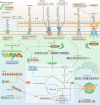Bacterial biopolymers: from pathogenesis to advanced materials
- PMID: 31992873
- PMCID: PMC7223192
- DOI: 10.1038/s41579-019-0313-3
Bacterial biopolymers: from pathogenesis to advanced materials
Abstract
Bacteria are prime cell factories that can efficiently convert carbon and nitrogen sources into a large diversity of intracellular and extracellular biopolymers, such as polysaccharides, polyamides, polyesters, polyphosphates, extracellular DNA and proteinaceous components. Bacterial polymers have important roles in pathogenicity, and their varied chemical and material properties make them suitable for medical and industrial applications. The same biopolymers when produced by pathogenic bacteria function as major virulence factors, whereas when they are produced by non-pathogenic bacteria, they become food ingredients or biomaterials. Interdisciplinary research has shed light on the molecular mechanisms of bacterial polymer synthesis, identified new targets for antibacterial drugs and informed synthetic biology approaches to design and manufacture innovative materials. This Review summarizes the role of bacterial polymers in pathogenesis, their synthesis and their material properties as well as approaches to design cell factories for production of tailor-made bio-based materials suitable for high-value applications.
Conflict of interest statement
B.H.A.R. is a co-founder and shareholder of PolyBatics Ltd, which commercializes veterinary tuberculosis diagnostic products related to protein-coated polyester spheres assembled in engineered
Figures





References
-
- Flemming HC, et al. Biofilms: an emergent form of bacterial life. Nat. Rev. Microbiol. 2016;14:563–575. - PubMed
Publication types
MeSH terms
Substances
LinkOut - more resources
Full Text Sources
Other Literature Sources
Molecular Biology Databases

